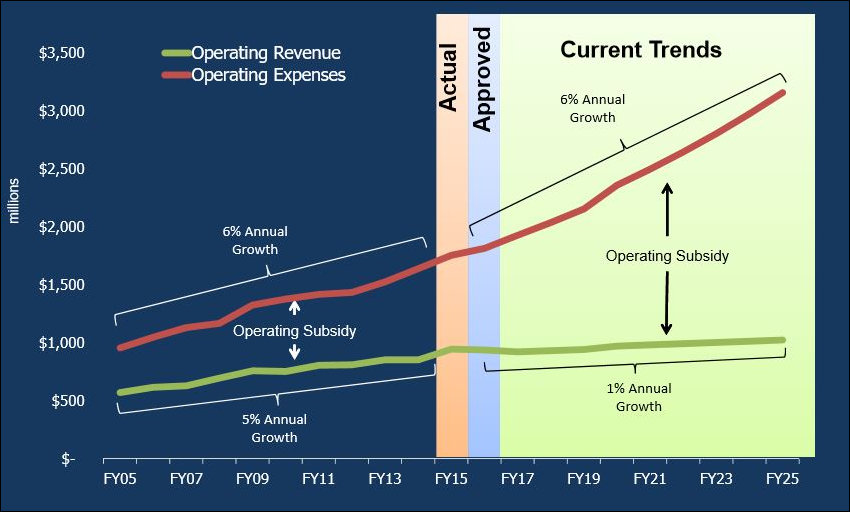
WMATA’s financial problem in a nutshell: Expenses, particularly labor expenses, are out of control. Source: WMATA
by James A. Bacon
The 2010s were supposed to be the era of mass transit in the Washington metropolitan region. Millenials were jettisoning their automobiles in favor of walking, biking, buses and rail. Localities were zoning for denser development around transit stops and Metro stations. State and federal governments were channeling more money into new rail projects. Real estate developers were plowing billions of dollars into transit-oriented development. But something unexpected happened along the way.
Washington Metropolitan Area Transit Authority ridership actually declined by 17 million between fiscal 2013 and 2015, to 362 million trips, despite the Silver Line expansion of Metro rail. Given the deteriorating fiscal condition of the rail and bus network, which has a $3 billion capital and operating budget this year, that number does not seem likely to improve. In a system dogged by safety incidents, poor on-time performance and broken escalators, customer satisfaction is declining. Meanwhile, capital spending can’t keep up with depreciation, suggesting that service is likely to get worse, not better.
WMATA projects 1% revenue growth over the next five years but 6% growth in expenses, requiring a relentless increase in state and local subsidies. To balance the current budget, eight county and city jurisdictions jacked up subsidies from $780 million to $877 million. Not only does WMATA propose to lock in those higher subsidies, it proposes increasing them at the rate of 3% annually over five years.
In a FY 2017 budget guidance document, WMATA management acknowledges that local governments will be hard pressed to deliver. “Some jurisdictional representatives have made it clear that they cannot sustain such high levels of subsidy growth year over year given their own revenue growth and competing needs for investment in tools, public safety and other priorities.”
So, what can be done? As Martin Di Caro writes for WAMU.org, rising personnel costs account for 70% of the cost growth in the 10-year outlook. The current contract with the Amalgamated Transit Union expires June 30. Given the potential for disruptive strikes, however, it’s not clear that management has the stomach to extract significant concessions from the union, either in reduced compensation or reform of productivity-sapping work rules.
Another option is raising fares — charging riders a higher percentage of what it costs to provide a ride. Di Caro considers a fare increase “likely,” although higher fares are likely to depress ridership, undermining the goal of raising revenue. Yet another alternative is pruning money-losing bus lines, although cutting service would not endear WMATA to the localities it is asking to pay bigger subsidies.
As WMATA rightly observes, a system failure is unthinkable. WMATA provides a critical service; the Washington-area transportation system cannot function without it. But it’s clear the system is in a slow-motion train wreck.
Bacon’s bottom line: WMATA should be a warning to every Virginia jurisdiction about what can go wrong with mass transit. The blue-state mass transit model is broken. By “blue state,” I refer to a set of attitudes that are most prevalent in blue states: a sympathy for transit unions, which means high compensation costs and low productivity; a reluctance to charge riders the full costs of providing their service, which depresses revenues; and a proclivity to seek federal aid, which comes with expensive regulatory strings attached.
The only good news in this picture is that transportation is undergoing a shared-ridership revolution, in which private companies use smart phone apps, savvy algorithms and flexible routes to provide bus and van service at a competitive price. Instead of increasing subsidies for a failing business model, Virginia’s Department of Rail and Public Transportation and local governments should be asking themselves how they can foster the rise of the new mass transit paradigm.
(Hat tip: Tim Wise.)


